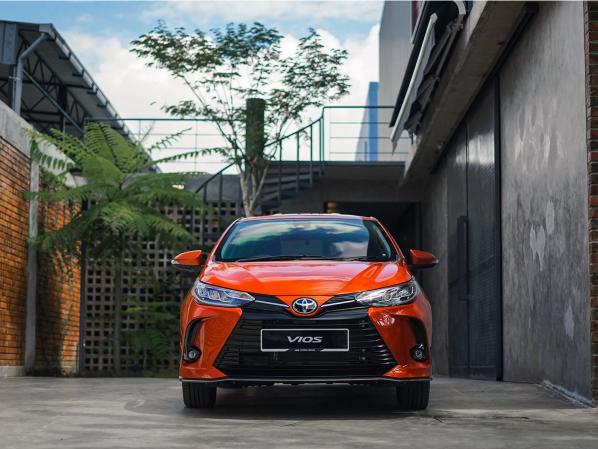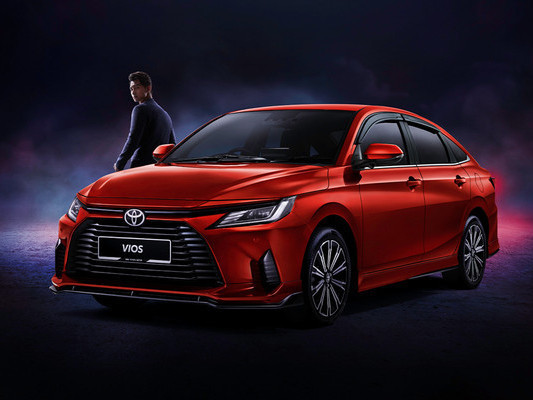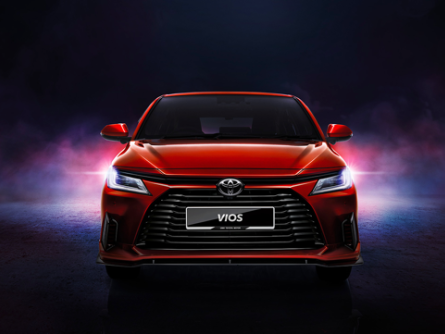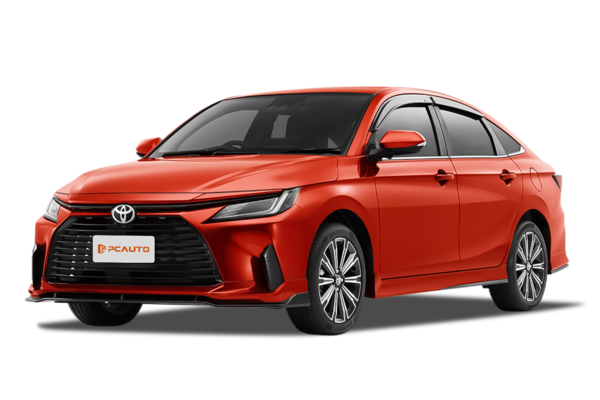Q
How many models does Toyota Vios have?
The main advantage of the Toyota Vios' acoustic windshield is that it significantly enhances in-cabin quietness. This glass features a special laminated design (typically incorporating a PVB sound-insulating film or a double-glazed structure), which effectively blocks high-frequency wind noise and external ambient sounds like traffic hustle and bustle. The improvement in driving comfort is particularly noticeable during common scenarios in Malaysia, such as city traffic jams or highway stretches. Additionally, acoustic glass filters out some UV rays, indirectly protecting the interior and reducing heat buildup from direct sunlight, which can improve air conditioning efficiency when used in conjunction with the system. From a technical standpoint, acoustic glass is part of the overall NVH (Noise, Vibration, and Harshness) optimization of the vehicle. Other models like the Honda City also employ similar technology, though the actual effectiveness depends on the coordinated design of glass thickness and body sealing. It's worth noting that such features might be exclusive to higher trim levels. When shopping, you can compare differences in sound-insulating materials across various versions, and regularly check the condition of glass seal strips to ensure long-term soundproofing performance.
Special Disclaimer: This content is published by users and does not represent the views or position of PCauto.
Related Q&A
Q
What is the maintenance schedule for a 2021 Vios?
For the 2021 Toyota Vios, it's recommended to get regular maintenance every 6 months or 10,000 kilometers, whichever comes first. This typically includes an engine oil change, oil filter replacement, brake system check, tire pressure inspection, and chassis bolt tightening. At 20,000 kilometers, you'll need to additionally inspect or replace the air filter and cabin air filter. Then, around 40,000 kilometers, it's a good idea to swap out the brake fluid and spark plugs to keep the engine running at its best.
Malaysia's hot and humid climate can speed up fluid degradation, so owners might want to shorten the intervals for coolant and transmission fluid changes to roughly 60,000 kilometers. It's worth noting that if you often drive in heavy traffic or take frequent short trips—what we call "severe driving conditions"—this can increase wear and tear on components. In those cases, consider changing the engine oil every 5,000-7,000 kilometers instead.
Sticking with Toyota Genuine oil as recommended by the factory, like 5W-30 viscosity, will help the engine handle the local heat better and also keep your original warranty intact. Regular maintenance isn't just about keeping performance up; it also lets mechanics use computer diagnostics to spot potential issues early. For example, checking the battery life is super important here in Malaysia to prevent starting problems during the rainy season.
Q
What is the engine of the Toyota Vios 2021?
The 2021 Toyota Vios in the Malaysian market comes with a 1.5-liter 2NR-FBE four-cylinder naturally aspirated petrol engine, featuring Dual VVT-i technology. It cranks out 107 horsepower (79 kW) and 140 Nm of torque, paired with a CVT gearbox that simulates 7 speeds. This powertrain focuses on fuel efficiency and smooth driving, with an official combined fuel consumption of around 5.1 liters/100 km. What's worth noting is the aluminum cylinder block that cuts weight, and the optimized intake and exhaust system which boosts low-end torque – perfect for Malaysia's stop-and-go city traffic. In its class, the Vios isn't about high performance, but it's known for durability and low maintenance costs, staying true to Toyota's practical reputation. If you need more power, some rivals offer turbo options, but the naturally aspirated engine still holds the edge in long-term running costs and easy repairs – that's part of why the Vios remains a hit in Malaysia's family car scene.
Q
Is Toyota Vios made in China?
The Toyota Vios in the Malaysian market mainly comes from production in Thailand, not China. As Toyota's key production base in Southeast Asia, Thailand manufactures the Vios specifically designed for the ASEAN region, making it better suited to local climate and road conditions while maintaining Toyota's usual reliability. As a global strategic model for Toyota, the Vios has different production layouts in various regions. For example, models sold in the Chinese market may be produced by local joint ventures, but the Vios supply in Malaysia is primarily imported from Thailand. This explains why Vios vehicles in Malaysia often have "Made in Thailand" on their nameplates. For Malaysian consumers, choosing a Thai-produced Vios actually has certain advantages: the Thai factory has mature craftsmanship, the parts supply chain is similar to Malaysia's, leading to relatively lower maintenance costs later on. Additionally, vehicles produced in Thailand enjoy tariff benefits under ASEAN trade agreements, which indirectly enhances the Vios' value for money in the Malaysian market. If there are doubts about the vehicle's origin, it is recommended to further confirm through the first letter of the Vehicle Identification Number (VIN) or the vehicle nameplate; typically, Thai-made Vios have a VIN starting with "M".
Q
What are common Vios problems?
The Toyota Vios is a top-selling entry-level sedan in the Malaysian market, boasting solid overall reliability. However, there are a few common issues owners should keep an eye on. For instance, some early models might experience unstable engine idling or slight vibrations, usually linked to throttle body carbon buildup or aging spark plugs—regular cleaning and maintenance are recommended. Additionally, suspension bushings on certain model years can develop squeaks after prolonged use, especially given Malaysia's rough road conditions; replacing the rubber components promptly should fix this. The CVT transmission may occasionally have minor jerking in extreme traffic jams, but regular oil changes can effectively extend its lifespan. The electric power steering system might trigger a protection mode after long hours of operation in high temperatures, causing heavier steering feel—simply turning off the engine and restarting should restore normal function. Notably, the Vios has a rather unique air filter placement, making DIY replacements a bit tricky; it’s advisable to follow the manual for that. These are all normal wear-and-tear issues. As long as you stick to the manufacturer’s recommended 10,000 km service intervals, the Vios remains quite durable under Malaysia’s hot climate and varied road conditions. For Malaysian consumers on a budget who value hassle-free practicality, it’s still a worthy option to consider.
Q
How reliable is the 2021 Toyota Vios?
The 2021 Toyota Vios has delivered impressive reliability in the Malaysian market. True to Toyota's reputation for durability, it's powered by a proven 1.5L Dual VVT-i engine paired with a CVT transmission, offering smooth power delivery and excellent fuel efficiency—perfect for local city driving. Maintenance costs are relatively low, parts are readily available, and repairs are hassle-free. Toyota's extensive after-sales service network in Malaysia further enhances the ownership experience. Based on owner feedback, common concerns mainly center on details like sound insulation and interior materials, but mechanical failure rate is extremely low. As an economy sedan, its overall performance meets or even exceeds expectations. It's worth noting that the Vios achieved a 5-star rating in ASEAN NCAP crash tests, ensuring safety. For Malaysian consumers with limited budgets who value reliability, it's a practical choice, and its resale value leads the segment, giving it an edge in long-term ownership costs.
Q
Is the Toyota Vios a SUV?
The Toyota Vios isn't an SUV—it's a compact four-door sedan (B-segment sedan), designed mainly for city commuting and daily family use. It's super popular in Malaysia thanks to its fuel efficiency, reliability, and great value for money. The Vios sits lower to the ground, with a obviously different ride height compared to SUVs (which usually have more ground clearance for rough roads), and it doesn't come with SUV staples like four-wheel drive. Instead, it's all about nimble handling and comfort. If you're after a Toyota SUV in a similar price range, check out the Raize or Rush. Both have taller ride heights and boxier body styles, making them better for different types of terrain. When Malaysian buyers are picking a car, it's important to know the difference between categories. Sedans are good for highway driving and better on fuel, while SUVs offer more ground clearance and flexible space. It really comes down to your actual needs—like the roads you'll be driving on or how many family members you have. And hey, all Toyota models in Malaysia come with a solid after-sales service network, so that's a plus.
Q
Is the 2021 Venza expensive to maintain?
The 2021 Toyota Venza's maintenance costs in Malaysia are on the upper end of the medium range. Since it comes with a hybrid system, daily upkeep expenses might be slightly higher than traditional gasoline-powered vehicles, but over the long haul, you can save some money through its lower fuel consumption. Regular maintenance like oil changes and filter replacements costs are similar to other SUVs in its class, roughly between RM400 and RM600, depending on the service center's pricing. The hybrid battery is pretty durable and generally doesn't need frequent replacement, but if it does need changing after the warranty expires, the cost could be steep. It's advisable for owners to stick to the official maintenance schedule to extend the vehicle's lifespan and keep costs in check. Malaysia's climate has minimal impact on battery performance, but regular checks of the cooling system and electrical components are still important. Toyota has an extensive after-sales service network in Malaysia with ample supply of genuine parts, which helps reduce repair waiting times and potential costs. For consumers considering a used Venza, it's recommended to check the maintenance records to ensure the previous owner kept up with proper servicing. Hybrid vehicle maintenance requires specialized technicians, so choosing an authorized service center is a smart move.
Q
What is the difference between 2021 and 2023 Toyota Vios?
The main differences between the 2021 and 2023 Toyota Vios lie in upgrades to exterior design, tech features, and safety performance. The 2023 Vios gets a more modern front-end design, including a redesigned grille and LED headlight assembly, giving it a sportier overall look. Inside, the 2023 model ups the ante with a larger infotainment screen and supports more advanced smartphone connectivity, like wireless Apple CarPlay and Android Auto, making it more user-friendly. When it comes to safety, the 2023 Vios comes standard with Toyota Safety Sense active safety suite, packing features like pre-collision warning, lane departure alert, and automatic high beam adjustment, offering more comprehensive protection compared to the 2021 version. Both models share the same powertrain – the trusty 1.5-liter Dual VVT-i engine paired with a CVT transmission – but the 2023 Vios gets some minor tweaks to boost fuel efficiency. For Malaysian consumers, the 2023 Vios upgrades are all about added value, especially with competition heating up in the segment, these improvements help it stay competitive. It's worth noting that Vios models in Malaysia usually get some market-specific tweaks to meet local needs, like beefed-up air conditioning systems to handle the tropical climate – details that carry over to both model years.
Q
How much is Toyota Vios in Indonesia?
In the Indonesian market, the price of the Toyota Vios varies depending on the trim and configuration. The base manual transmission version starts at around 270 million Indonesian rupiah (approximately RM82,000), while the top-spec automatic model can go up to 350 million Indonesian rupiah (about RM106,000). Actual prices may be affected by local taxes, promotional policies, and other factors. The Indonesian-spec Vios has slight configuration differences compared to the Malaysian version. For instance, the Indonesian market places more emphasis on practical features like rear-seat air-conditioning vents, whereas the Malaysian variant might highlight a more tech-forward feel. For Malaysian consumers considering cross-border purchases, it’s important to note the differences in vehicle specifications between the two countries, including emission standards, warranty terms, and right-hand drive vs. left-hand drive compatibility—all of which could impact the user experience and long-term maintenance costs. Additionally, the Vios is generally known for its durability and fuel efficiency across Southeast Asian markets, making it suitable for city commuting, though tuning tweaks in different countries may result in subtle variations in driving feel.
Q
What generation is Vios in 2021?
The Toyota Vios sold in the Malaysian market in 2021 belongs to the third-generation model (codenamed XP150). This generation has undergone several minor facelifts since its launch in 2013. The 2021 model continues with this generation's architecture but comes with an upgraded 1.5L Dual VVT-i engine paired with a CVT transmission, delivering excellent fuel efficiency. The third-gen Vios is widely popular in Malaysia for its durability and low maintenance costs. It measures 4,425mm in length, 1,730mm in width, and 1,475mm in height, with a 2,550mm wheelbase, offering relatively spacious rear-seat room in its class. It's worth noting that some Southeast Asian countries welcomed the all-new fourth-generation Vios based on the DNGA platform in 2023, but the Malaysian market followed suit a bit later due to strategic adjustments. The current third-gen Vios is locally assembled (CKD) with a cooling system optimized for tropical climates. It comes standard with 7 airbags (on higher-spec variants) and Toyota Safety Sense active safety technology. Its used car value retention rate has long been at the forefront of B-segment sedans in Malaysia, making it still a practical choice for budget-conscious buyers.
Popular Cars
Model Year
Car Compare
Car Photo
Latest Q&A
Q
What is the rpm of 180 hp motor?
The powerband of a 180-horsepower engine varies by model and intended design. Naturally aspirated engines typically hit peak power at 6,000-7,000 rpm, while turbocharged units like common 1.5T or 2.0T engines often deliver maximum punch between 5,000-6,000 rpm.
Remember the horsepower equation "HP = Torque × RPM ÷ 5252"? That's why modern turbo engines feel punchier at lower revs while sipping less fuel - they're making the same power with fewer revolutions.
Real talk though: you'll rarely need to wring it out to redline in daily driving. Most scenarios call for just 3,000-4,000 rpm for decent shove. Holding high revs constantly? That's just wearing out your engine faster.
Brands tune these differently too - some prioritize low-end grunt for city crawling, while others build power up top for highway passing. Match your right foot's personality when choosing.
Q
What is the rpm of a 10 hp motor?
The RPM of a 10-horsepower (hp) motor depends on its type and intended use. Typically, standard AC induction motors run between 1,450 and 2,900 RPM, while DC or variable-frequency motors may have a wider range—check the nameplate or technical manual for specifics.
In automotive applications, like small generators or auxiliary systems, a 10-hp motor’s speed is often matched to the vehicle’s needs. For example, certain booster pumps or cooling fans might operate between 1,800 and 3,600 RPM.
Keep in mind that horsepower (hp) and RPM aren’t directly linked. HP reflects power output, while RPM depends on factors like pole count and supply frequency (e.g., a 4-pole motor in a 50Hz region runs around 1,440 RPM). If you’re swapping or modifying a motor, always verify the torque curve and load requirements to avoid efficiency losses or damage.
Also, in EVs or hybrids, motors often run at much higher speeds (8,000 RPM or more), though these systems usually rate power in kilowatts (kW)—just remember 1 hp ≈ 0.746 kW for conversion.
Q
How to convert HP into RPM?
To convert horsepower (HP) to RPM, you need to understand their relationship—but there’s no direct conversion since HP measures power while RPM reflects crankshaft speed. Torque bridges the gap. The formula is:
**HP = (Torque × RPM) / 5252** (with torque in lb-ft).
Rearrange it to solve for RPM:
**RPM = (HP × 5252) / Torque**.
For example, an engine making 200 HP at 300 lb-ft of torque hits roughly 3500 RPM at that output.
Keep in mind:
- Engines have unique powerbands—peak HP and torque rarely align at the same RPM.
- Turbocharging, aspiration, and transmission gearing all alter how power translates to wheel speed.
- Real-world performance isn’t just about this math; check the dyno curve and drivetrain setup for the full picture.
Q
What is the rpm of a 60 hp motor?
A 60-horsepower engine's RPM range depends entirely on its design and application. For small gasoline engines, you're typically looking at 6,000-8,000 RPM to hit 60 hp. Diesel mills, with their torque advantage, can achieve the same power at just 3,000-4,500 RPM - check the manufacturer's power curve for exact figures.
Remember, horsepower doesn't scale linearly with RPM. Cylinder count, induction type (naturally aspirated vs. forced induction), and fuel delivery all play major roles. Take turbocharged engines - they'll deliver peak power at significantly lower revs.
For daily driving, most cars operate most efficiently in the 2,000-3,000 RPM sweet spot where power and fuel economy balance out. Want specifics on your ride? Crack open the owner's manual or hook up an OBD scanner. Tuning enthusiasts can always flash the ECU to alter power delivery, but be warned - that warranty won't honor itself, and reliability might take a hit.
Q
How many rpm is a 2 hp motor?
There’s no fixed direct relationship between a motor’s RPM and its horsepower (HP), as rotational speed depends on factors like motor design, load conditions, and power supply frequency. For example, a 2 HP AC motor under a 50Hz power standard (common in household or industrial use) typically has a synchronous speed of around 1500 RPM or 3000 RPM—determined by its pole count (4-pole or 2-pole)—though actual operating speed may drop slightly under load.
For DC or brushless motors, the RPM range can vary more widely, so always check the specs for the specific model. Application also plays a role: a 2 HP motor for pumps or fans usually runs at moderate speeds, while power tools may prioritize higher RPMs.
When selecting a motor, don’t just focus on power—consider torque, efficiency, and rated speed to match real-world needs. For precise figures, consult the manufacturer’s datasheet or a technical expert.
View MoreRelated News

Toyota Vios Interior Design Revealed: A Balance of Functionality and Aesthetics
LienJul 18, 2025

Toyota Vios : An In-Depth Buying Guide
LienMar 25, 2025

2023 Toyota Vios: 'Baby Camry' Gets an Upgrade, How to Choose Between It and the Honda City?
WilliamSep 14, 2024

Toyota Vios: Selling price starts from RM 89,600, is it a Mini Camry?
LienMay 28, 2024

The new Toyota Corolla is launched in China, with a wheelbase extended to 2750mm
AshleyDec 23, 2025
View More

















Pros
Cons